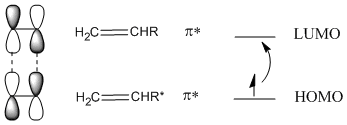
Figure OC6.1. The Diels Alder reaction.
Reactivity in Chemistry
Reactions Under Orbital Control
OC6. Photochemical Cycloaddition
As noted previously, the Diels Alder reaction is a classic example of a pericyclic reaction.
Figure OC6.1. The Diels Alder reaction.
A Diels Alder reaction is sometimes called a [2+4] addition reaction. A 2-carbon unit on one molecule interacts with a 4-carbon unit on another molecule.
In contrast, the addition of one regular alkene to another regular alkene would be called a [2+2] addition reaction. If this reaction occurred, two alkenes would come together to form a four-membered ring.
Figure OC6.2. A [2+2] addition reaction.
However, [2+2] addition reactions don't occur without special circumstances. There are a couple of reasons why, and you may be able to suggest some at this point.
You might say that the four-membered ring would be much more strained than the six-membered ring formed by the Diels Alder reaction. That is true, but it may not be reason enough to prevent the reaction from happening. Four-membered rings do occur in nature despite their strain energy.
You might also say that the benzene-like transition state that stabilizes the pathway through a Cope or Diels Alder reaction isn't possible in a [2+2] addition. In fact, the transition state would be more like antiaromatic cyclobutadiene. The transition state would be very high in energy.
Another problem shows up if we look at the orbital interactions in a [2+2] addition reaction. The HOMO on one alkene and LUMO on the other alkene do not overlap so that bonds can form between the two ends. If the p orbitals on one end are in phase, the p orbitals on the other end must be out of phase. The concerted reorganization of bonding possible for the Diels Alder reaction can't happen here.
Figure OC6.3. Qualitative molecular orbital picture of [2+2] addition reaction.
In fact, there is a way around that problem. Irradiating an alkene with UV light leads to promotion of an electron from the LUMO to the HOMO. The alkene is now in an "excited state".

Figure OC6.4. Excitation of an electron in an alkene.
This does not happen with 100% efficiency, so only some of the alkenes will become excited. In the excited state alkene, the HOMO now resembles the LUMO of the ground state alkene. Because of the matching symmetry between these orbitals, the addition reaction can proceed.

Figure OC6.5. HOMO-LUMO interaction between a ground-state alkene and an excited-state alkene.
A [4+2] reaction is sometimes referred to as "thermally-allowed", whereas a [2+2] addition is sometimes referred to as "photolytically-allowed." This distinction refers to the need for electronic excitation to accomplish the latter type of reaction.
This site is written and maintained by Chris P. Schaller, Ph.D., College of Saint Benedict / Saint John's University (retired) with contributions from other authors as noted. It is freely available for educational use.

Structure & Reactivity in Organic, Biological and Inorganic Chemistry by Chris Schaller is licensed under a Creative Commons Attribution-NonCommercial 3.0 Unported License.
This material is based upon work supported by the National Science Foundation under Grant No. 1043566.
Any opinions, findings, and conclusions or recommendations expressed in this material are those of the author(s) and do not necessarily reflect the views of the National Science Foundation.
Navigation: